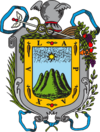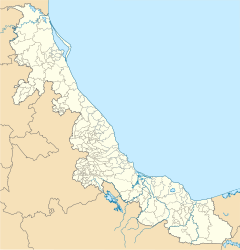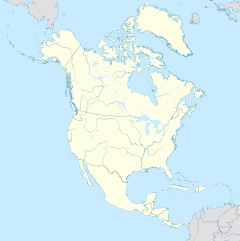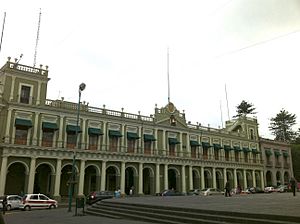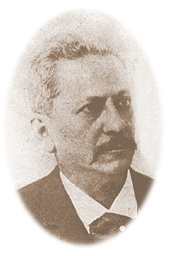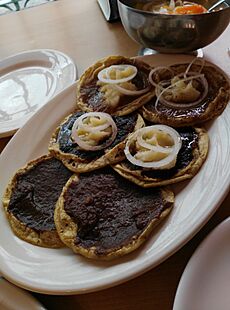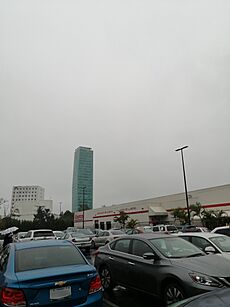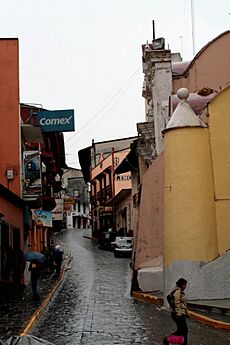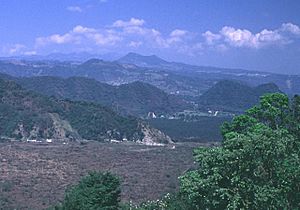Xalapa facts for kids
Quick facts for kids
Xalapa
Xalapan
Jalapa
|
||
|---|---|---|
|
Municipality and City
|
||
| Xalapa-Enríquez | ||
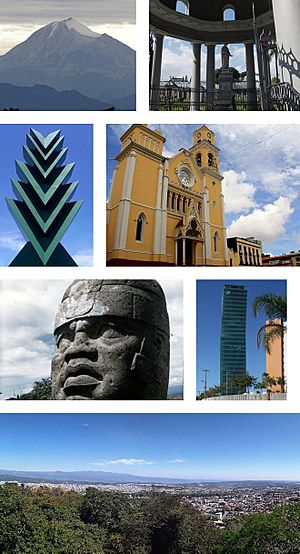
Clockwise, from upper left: Pico de Orizaba, General Juan de la Luz Enríquez Lara tomb, Xalapa Cathedral, Centro Mayor Tower, panoramic view from the Macuiltepetl's Mountain, Olmec colossal head from Museo de Antropología de Xalapa, Araucaria sculpture.
|
||
|
||
| Nickname(s):
La Ciudad de las Flores
("The City of Flowers") |
||
| Motto(s):
Xalapa
|
||
| Country | ||
| State | Veracruz | |
| Founded | 1313 | |
| Declared as a city | December 18, 1791 | |
| Area | ||
| • Total | 124.4 km2 (48.0 sq mi) | |
| Elevation | 1,417 m (4,649 ft) | |
| Population
(2020)
|
||
| • Total | 488,531 | |
| • Density | 3,927.8/km2 (10,173/sq mi) | |
| • Seat | 443,063 | |
| • Metro | 789,157 | |
| • Metro density | 622.21/km2 (1,611.5/sq mi) | |
| GDP (PPP, constant 2015 values) | ||
| • Year | 2023 | |
| • Total (Metro) | $9 billion | |
| • Per capita | $11,000 | |
| Time zone | UTC−6 (CST) | |
| Website | www.xalapa.gob.mx | |
Xalapa, also known as Jalapa, is the capital city of the Mexican state of Veracruz. Its official name is Xalapa-Enríquez. In 2020, the city had about 443,063 people living there. The larger area around it, called the municipality, had 488,531 people. Xalapa is located near the middle of Veracruz state. It is the second-largest city in Veracruz, after the city of Veracruz itself.
Contents
- What's in a Name? The Meaning of Xalapa
- A Journey Through Time: Xalapa's History
- Culture: The Heart of Xalapa
- Amazing Places to See in Xalapa
- Education: A City of Learning
- Sports: Home of Champions
- Economy: How Xalapa Works
- Getting Around: Transportation in Xalapa
- Healthcare: Staying Healthy in Xalapa
- Media: News and Entertainment
- Famous People from Xalapa
- Xalapa's Location and Surroundings
- Climate: The Weather in Xalapa
- Population: Who Lives in Xalapa?
- Sister Cities: Xalapa's Friends Around the World
- See also
What's in a Name? The Meaning of Xalapa
The name Xalapa comes from an old language called Classical Nahuatl. It combines two words: xālli, meaning 'sand', and āpan, meaning 'place of water'. So, Xalapa means something like 'spring in the sand'.
The full name of the city is Xalapa-Enríquez. This was added to honor Juan de la Luz Enríquez, a governor from the 1800s. The city is also called "City of Flowers" (Spanish: La ciudad de las flores). This nickname was given by a famous explorer, Alexander von Humboldt, who visited in 1804. People from Xalapa are called Xalapeños or Jalapeños. This is also the name of the popular spicy peppers grown in this area!
A Journey Through Time: Xalapa's History
Xalapa has a long and interesting history, starting with ancient peoples and growing into the city it is today.
Early Settlements and Aztec Rule
The first people to settle in this area were the Totonacs. They lived around a mountain called Macuiltepetl, which means "fifth mountain" in Nahuatl. This mountain is now a park.
Around the 1300s, four different groups of people settled here. Each group built a small village:
- The Totonacas founded Xalitic ('in the sand').
- The Toltecas founded Tecuanapan ('river of the beasts').
- The Teochichimecas founded Tlalnecapan.
Around 1313, these four villages grew and joined together. They formed one larger village called Xallapan. Later, in the 1400s, the Aztec emperor Moctezuma Ilhuicamina took control of the area. Xalapa remained part of the Aztec Empire until the Spanish arrived.
Spanish Arrival and Colonial Growth
In 1519, the Spanish explorer Hernán Cortés passed through Xalapa on his way to Tenochtitlan. In 1555, Spanish Franciscans built an important convent here.
When the Spanish first arrived, Xalapa was not very big. But its population grew after the Spanish conquest. For a while, Xalapa became less important as a travel stop.
Becoming a Key Trading Hub
From the 1720s, Xalapa started to become very important again. This was because it became a busy place for merchants to trade goods. Many Spanish families moved to Xalapa, and by 1760, over 1,000 people lived there.
One important product traded here was a plant called ipomoea purga, which was used for medicine. Because Xalapa grew so much in population and trade, Carlos IV of Spain officially declared it a town on December 18, 1791.
Milestones and Famous Visitors
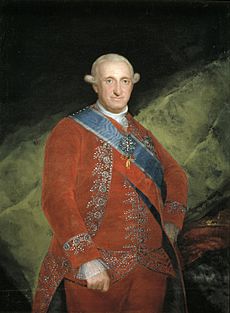
In 1772, work began on the beautiful Xalapa Cathedral. On May 18, 1784, the first air balloon in the Americas was flown in Xalapa by José María Alfaro!
When Alexander von Humboldt visited in 1804, he was so impressed by the many flowers that he called Xalapa the "city of the flowers." On November 29, 1830, Xalapa was officially named a city.
War and Education
In 1847, during the Mexican–American War, a big battle happened near Xalapa. Mexican General Antonio López de Santa Anna led over 12,000 soldiers. Many soldiers were hurt or killed. The US forces then occupied the city.

One of the US soldiers was Lt. Ulysses S. Grant, who later became a famous general. He wrote that Xalapa was "decidedly the most beautiful place I ever saw in my life."
Two local heroes, Ambrosio Alcalde and Antonio García, fought bravely. They were captured and later executed. Today, an obelisk remembers their sacrifice.
In November 1862, Xalapa was attacked during the French invasion. Later, in 1867, the body of Emperor Maximilian I of Mexico was held in Xalapa before being sent back to Austria.
The "Athens of Veracruz"
In 1885, General Juan de la Luz Enríquez helped Xalapa become even more important. He moved some government offices here. In 1886, he and Swiss teacher Enrique C. Rébsamen founded the Normal School in Xalapa. This was the first school of its kind in Mexico, training teachers.
Because of these schools, Xalapa became known as a center for learning. It earned the nickname "Athens of Veracruz."
Culture: The Heart of Xalapa

Xalapa is famous for its culture, thanks to its big university, Universidad Veracruzana. This university helps make Xalapa a hub for arts and learning.
The city has many theaters, museums, and street art. You can often see musicians and dancers performing in the city center, especially during celebrations. They often perform the fandango, a lively dance.
Art is very important in Xalapa. The Pinacoteca Diego Rivera gallery has the largest collection of Diego Rivera's paintings in all of Mexico.
Celebrating Holidays
Xalapa celebrates many holidays. Some important ones include:
- Feast day of San José
- Feast of Santiago Apostle
- Feast of the Immaculate Heart of Jesus
- Conception of Maria
- Expo-Fair International
A very important religious holiday is on December 8, the Feast of the Immaculate Conception. On October 24, thousands of people visit the tomb of San Rafael Guizar and Valencia in the cathedral.
Delicious Xalapa Food
Did you know that the famous jalapeño peppers come from Xalapa?
Local dishes often use corn, like:
- gorditas
- tostadas
- pasties
- enfrijoladas
- Chicken dishes
For dessert, people enjoy sweet treats like:
- Cakes
- cocadas (coconut sweets)
- candied fruit
- dulce de leche (caramelized milk)
- jamoncillo (a milk candy)
Amazing Places to See in Xalapa
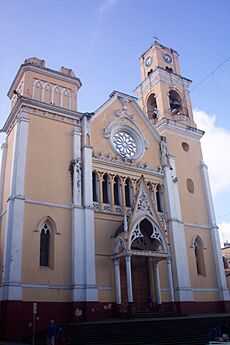
Xalapa has many interesting landmarks and places to visit.
- The Xalapa Cathedral: This church was built in 1773 and has a mix of old styles. Its clock tower has a clock from England.
- Callejón Diamante (Diamond Alley): This is a popular street at night with cafes and artists.
- Patio Muñoz: A historic neighborhood from the 1800s with original buildings. You can find art, dance, and music workshops here.
- Parque Juárez: A central park where a monastery once stood. It has huge monkey puzzle trees, art galleries, and a cafe.
- The Jardín de Esculturas (Sculpture Garden): A museum showing sculptures by famous artists.
- The Museo Interactivo de Xalapa (Interactive Museum of Xalapa): This museum has a planetarium with an IMAX screen for educational films.
- Paseo de los Lagos: This area used to be an old dam. Now it has walking paths around three lakes and a fresh-water spring.
- Parque de los Tecajetes: A park in a natural dip in the city. It has a spring that feeds its pools and canals.
- The Museo de Antropología de Xalapa (Anthropology Museum of Xalapa): This museum has the largest collection of items from ancient Mexican cultures like the Olmec, Huastec, and Totonac. It has over 25,000 pieces, including giant Olmec heads. Some pieces are from as far back as 1300 BC!
- Hacienda del Lencero: This old estate was once owned by a soldier of Hernán Cortés and later by Antonio López de Santa Anna. Today, it's a museum with 19th-century furniture, a chapel, gardens, and a lake.
- Jardín Botánico Clavijero (Clavijero Botanical Garden): This garden has a large collection of local plants, including Mexican ornamental flowers and many types of pines.
Parks and Green Spaces
Xalapa is known for its many beautiful parks and gardens:
- Jardín Botánico de Xalapa
- Parque Juárez
- Parque Los Berros
- Parque Ecológico "Cerro del Macuiltépec"
- Paseo de Los Lagos
- Parque Ecológico "El Haya"
- Parque "Natura"
- Jardines de la Universidad Veracruzana
- Parque "Tejar Garnica"
- Jardín de las Esculturas
- Parque Ecológico de Los Tecajetes
- Parque María Enriqueta
- Parque Revolución
- Parque Bicentenario
- Stadium Xalapeño
Museums and Galleries
Xalapa has many places to explore art and history:
- Museo de Antropología de Xalapa
- Museo Casa de Xalapa
- Museo Interactivo de Xalapa
- Hacienda del Lencero
- Pinacoteca Diego Rivera
- Jardín de Esculturas
Theaters and Performance Venues
You can enjoy many shows and concerts in Xalapa:
- Teatro del Estado
- Sala de Conciertos de la Orquesta Sinfónica de Xalapa
- Teatro J. J. Herrera
- Teatro La Caja
- Auditorio de la Benemérita Escuela Normal Veracruzana
Education: A City of Learning
Xalapa is a major center for education in Mexico. It has many universities and schools, making it a great place for students.
Universities in Xalapa
- Universidad Anáhuac
- Benemérita Escuela Normal Veracruzana "Enrique C. Rébsamen"
- El Colegio de Veracruz
- Universidad Eurohispanoamericana
- Universidad Gestalt
- Universidad del Golfo de México, Campus Xalapa
- Instituto Tecnológico Superior de Xalapa
- Universidad Pedagógica Veracruzana
- Universidad Veracruzana (the main public university)
- Universidad de Xalapa
Sports: Home of Champions
Xalapa is home to the Halcones UV Xalapa, a very successful professional basketball team. They play in the LNBP.
The Halcones UV Xalapa team has achieved great success:
- In 2003, they finished 3rd in the LNBP.
- In 2004, they were champions of their division and 2nd overall.
- In 2005, they won their division and became champions of the LNBP!
- In 2006, they were division champions again and 2nd in the LNBP.
- In 2007–2008, they won their division and were LNBP champions again!
- In 2008–2009, they were division champions and LNBP champions for the third time!
Xalapa has many sports facilities, including:
- 25 soccer fields
- 95 volleyball fields
- 95 basketball courts
- 36 baseball fields
- 29 multi-use fields
- 12 gymnasiums
- 7 parks
- The famous Heriberto Jara Corona Stadium, opened in the 1920s.
Many talented athletes come from Xalapa, such as:
- Armando Fernández (an Olympic wrestler)
- Eulalio Ríos Alemán (an Olympic swimmer)
- Luis Hernández (a track and field athlete)
In 2014, Xalapa hosted several events for the Central American Games. This brought the city recognition in the sports world.
Economy: How Xalapa Works
Xalapa is sometimes called the "Flower Garden of Mexico" because flowers are important to its economy. The city is also a key place for coffee production in Mexico. Coffee beans are grown on farms in the surrounding mountains.
Other important industries include:
- Tobacco production (making cigarettes)
- Growing tropical fruits
- Producing processed foods and drinks
Many people in Xalapa work for the government because it is the state capital. The city is also a major center for legal services.
Xalapa is a busy place for business. Many big companies have stores and restaurants here. The city also has several cinemas and shopping malls. The supermarket chain Chedraui is based in Xalapa.
Here's how people in Xalapa were employed in 2005:
| Industry sector | What people do | % of population |
|---|---|---|
| Primary Industry | Farming, raising animals, hunting, and fishing | 4.21 |
| Secondary Industry | Making things, electricity, water, and building | 19% |
| Tertiary Industry | Shops, transport, money, and services | 70% |
| Unspecified | – | 2.9% |
Getting Around: Transportation in Xalapa
Xalapa is connected to other cities by highways. Highway 140-D links it to Veracruz, Puebla, and Mexico City.
Many bus companies operate in Xalapa, including:
- Servicio Urbano de Xalapa (SUX)
- Auto-Transportes Banderilla (ATB)
- Interbus
- Transportes Rápidos de Veracruz (TRV)
The city has a small airport called El Lencero Airport, about 15 minutes away. However, no commercial airlines currently fly there.
Healthcare: Staying Healthy in Xalapa
Xalapa has many hospitals and clinics, both public and private, to help people stay healthy.
Public Healthcare
- Instituto Mexicano del Seguro Social IMSS
- Instituto de Seguridad y Servicios Sociales de los Trabajadores del Estado ISSSTE
- Centro de Alta Especialidad CAE
- Petróleos Mexicanos PEMEX
- Secretaría de la Defensa Nacional SDN
- Secretaría de Salud de Veracruz SESVER
- Centro de Rehabilitación y Educación Especial de Veracruz CREEVER
- Sistema para el Desarrollo Integral de la Familia DIF
Private Healthcare
- Sanatorio San Francisco
- Clínica del American Hospital
- Clínica de especialidades Las Palmas
- Vital Clínica Hospital
- Cruz Roja Mexicana
- Centro Médico de Xalapa
- Clínica Millenium
- Hospital Ángeles
Media: News and Entertainment
Xalapa has many ways for people to get news and entertainment, including newspapers, radio, and television.
Newspapers
Some popular newspapers in Xalapa are:
- Diario de Xalapa
- Diario AZ
- Diario el Portal de Xalapa
- Periódico Marcha
- Milenio
- Líder
Radio Stations
You can listen to many radio stations in Xalapa:
- 90.5 Radio de la Universidad Veracruzana
- 91.7 Amor
- 95.5 Sensación HD
- 96.9 Digital 96.9
- 97.7 La Máquina
- 98.5 ONE FM
- 104.9 El Patron FM
- 107.7 Radio Más
Television Channels
Xalapa has several television channels:
- XHGV-TV channel 4 – RTV
- XHAJ-TV channel 5 – Televisa Regional
- XHAH-TV channel 7 – Canal de las Estrellas
- XHAI-TV channel 9 – Canal 5
- XHCPE-TV channel 11 – Azteca 7
- XHIC-TV channel 13 – Azteca 13
- XHCLV-TV channel 22 – Galavisión
Cable and satellite TV services are also available.
Famous People from Xalapa
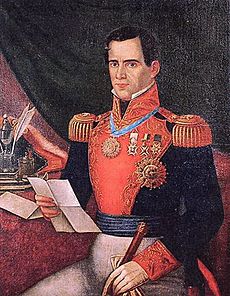
Many notable people have come from Xalapa, including:
Politicians
Writers
- Juan Díaz Covarrubias
- José María Roa Bárcena
Educators
- Enrique C. Rébsamen
Athletes
- Armando Fernández (Wrestler)
- Eulalio Ríos Alemán (Swimmer)
- Luis Hernández (Athlete)
Artists
- Gabriel Orozco (Artist)
- Javier Camarena (Opera singer)
Xalapa's Location and Surroundings
Xalapa is located in east-central Mexico, about 55 kilometers northwest of Veracruz city. It is roughly 350 kilometers from Mexico City.
The area of Xalapa municipality is about 118.45 square kilometers. It shares borders with several other municipalities.
About 50 kilometers east of Xalapa is the Cofre de Perote National Park. This park has forests, mountains, and hills. Its highest point is Cerro de Macuiltépetl, which is 1522 meters above sea level.
From Xalapa, you can also see Pico de Orizaba. This is the highest peak in Mexico, standing at 5,366 meters (18,490 feet). It is also the third highest peak in North America.
Rivers and Waterfalls
The area around Xalapa has many streams and springs. Some of the rivers include:
- Sedeño River
- Carneros River
- Sordo River
- Santiago River
There are also three artificial lakes and several springs. The Cascada de Texolo (Texolo Waterfall) is about 19 kilometers southwest of Xalapa. It is an 80-meter waterfall that drops into a beautiful canyon.
Climate: The Weather in Xalapa
| Weather chart for Xalapa, Veracruz | |||||||||||||||||||||||||||||||||||||||||||||||
|---|---|---|---|---|---|---|---|---|---|---|---|---|---|---|---|---|---|---|---|---|---|---|---|---|---|---|---|---|---|---|---|---|---|---|---|---|---|---|---|---|---|---|---|---|---|---|---|
| J | F | M | A | M | J | J | A | S | O | N | D | ||||||||||||||||||||||||||||||||||||
|
42
22
11
|
38
23
11
|
46
27
14
|
61
27
16
|
121
28
17
|
328
26
16
|
203
25
16
|
171
26
16
|
270
26
16
|
105
25
15
|
67
24
14
|
50
23
12
|
||||||||||||||||||||||||||||||||||||
| temperatures in °C precipitation totals in mm |
|||||||||||||||||||||||||||||||||||||||||||||||
|
Imperial conversion
|
|||||||||||||||||||||||||||||||||||||||||||||||
Xalapa has a humid climate, but it stays relatively cool because it's in the mountains, over 1400 meters above sea level. The weather can change, but the temperature usually doesn't vary much throughout the year. The average yearly temperature is 18°C.
Seasons in Xalapa
- Warmer Season: From March to May, with May being the warmest month. The average high is 28°C, and the low is 17°C.
- Cooler Season: From late December to February. The average low is 11°C, and the average high is 22°C.
The best time to visit Xalapa for comfortable weather is from early November to mid-April. However, it's a good idea to bring warm clothes, as winter nights can sometimes drop close to 0°C.
Rain and Mist
Xalapa gets about 1509.1 millimeters of rain each year.
- Driest Months: January and February, with very little rain.
- Wettest Months: Summer months, especially June, when it rains a lot.
Snow is common in winter outside the city, in places like Perote, which is about 35 minutes from Xalapa. In the early morning, Xalapa often has a mist, giving it a special mountain feel.
| Climate data for Xalapa (1951–2010) | |||||||||||||
|---|---|---|---|---|---|---|---|---|---|---|---|---|---|
| Month | Jan | Feb | Mar | Apr | May | Jun | Jul | Aug | Sep | Oct | Nov | Dec | Year |
| Record high °C (°F) | 32.4 (90.3) |
33.4 (92.1) |
37.4 (99.3) |
37.0 (98.6) |
38.8 (101.8) |
36.0 (96.8) |
31.5 (88.7) |
31.9 (89.4) |
32.4 (90.3) |
32.9 (91.2) |
33.0 (91.4) |
32.5 (90.5) |
38.8 (101.8) |
| Mean daily maximum °C (°F) | 21.2 (70.2) |
22.5 (72.5) |
25.4 (77.7) |
27.2 (81.0) |
27.7 (81.9) |
26.3 (79.3) |
25.3 (77.5) |
26.0 (78.8) |
25.5 (77.9) |
24.3 (75.7) |
23.0 (73.4) |
21.7 (71.1) |
24.7 (76.5) |
| Daily mean °C (°F) | 15.8 (60.4) |
16.5 (61.7) |
19.2 (66.6) |
21.0 (69.8) |
21.9 (71.4) |
21.1 (70.0) |
20.3 (68.5) |
20.7 (69.3) |
20.5 (68.9) |
19.3 (66.7) |
17.7 (63.9) |
16.4 (61.5) |
19.2 (66.6) |
| Mean daily minimum °C (°F) | 10.4 (50.7) |
10.5 (50.9) |
13.0 (55.4) |
14.8 (58.6) |
16.1 (61.0) |
15.9 (60.6) |
15.3 (59.5) |
15.4 (59.7) |
15.6 (60.1) |
14.3 (57.7) |
12.5 (54.5) |
11.0 (51.8) |
13.7 (56.7) |
| Record low °C (°F) | 0.2 (32.4) |
0.0 (32.0) |
2.8 (37.0) |
4.0 (39.2) |
7.0 (44.6) |
9.0 (48.2) |
9.0 (48.2) |
9.5 (49.1) |
9.8 (49.6) |
5.0 (41.0) |
−2.2 (28.0) |
0.9 (33.6) |
−2.2 (28.0) |
| Average precipitation mm (inches) | 59.0 (2.32) |
41.8 (1.65) |
41.7 (1.64) |
56.7 (2.23) |
210.7 (8.30) |
222.1 (8.74) |
219.4 (8.64) |
164.2 (6.46) |
249.6 (9.83) |
113.5 (4.47) |
88.6 (3.49) |
74.3 (2.93) |
1,435.8 (56.53) |
| Average precipitation days (≥ 0.1 mm) | 12.4 | 11.9 | 11.1 | 9.4 | 11.1 | 19.6 | 19.0 | 16.5 | 19.3 | 16.9 | 12.6 | 13.0 | 172.8 |
| Average relative humidity (%) | 67 | 63 | 63 | 60 | 63 | 68 | 67 | 66 | 69 | 69 | 67 | 68 | 66 |
| Mean monthly sunshine hours | 143 | 133 | 166 | 155 | 159 | 138 | 215 | 168 | 132 | 145 | 154 | 142 | 1,850 |
| Source 1: Servicio Meteorologico Nacional (humidity 1981–2000) | |||||||||||||
| Source 2: Deutscher Wetterdienst (sun, 1961–1990) | |||||||||||||
Population: Who Lives in Xalapa?
| Historical population | ||
|---|---|---|
| Year | Pop. | ±% |
| 1995 | 336,632 | — |
| 2000 | 390,590 | +16.0% |
| 2005 | 413,136 | +5.8% |
| 2010 | 457,928 | +10.8% |
| 2015 | 480,841 | +5.0% |
| 2020 | 488,531 | +1.6% |
In 2020, Xalapa City had 443,063 people. The whole municipality had 488,531 people. This makes Xalapa the second-largest city and municipality in Veracruz by population.
The municipality has 63 smaller areas, called localities. Six of these are urban, and 57 are rural. Some other important localities include Santa Bárbara, El Castillo, and Lomas Verdes. About 6,542 people live in homes where an indigenous language is spoken.
Xalapa is also the center of a larger metropolitan area. This area includes Xalapa and eight other nearby municipalities. In 2020, this metropolitan area had 789,157 people. It is the second-largest metropolitan area in Veracruz.
Sister Cities: Xalapa's Friends Around the World
Xalapa has special connections with other cities, called "sister cities." These connections help promote cultural exchange and friendship.
 Covina, California, United States
Covina, California, United States La Antigua, Guatemalan Highlands, Guatemala
La Antigua, Guatemalan Highlands, Guatemala Matamoros, Tamaulipas, Mexico
Matamoros, Tamaulipas, Mexico Omaha, Nebraska, United States
Omaha, Nebraska, United States Puebla, Puebla, Mexico
Puebla, Puebla, Mexico Toluca, State of Mexico, Mexico
Toluca, State of Mexico, Mexico Torreón, Coahuila, Mexico
Torreón, Coahuila, Mexico Veracruz, Veracruz, Mexico
Veracruz, Veracruz, Mexico
See also
 In Spanish: Xalapa-Enríquez para niños
In Spanish: Xalapa-Enríquez para niños


